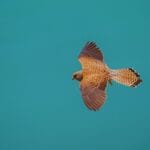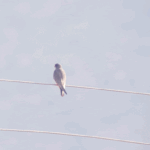World Migratory Bird Day (WMBD) – marks an important date in AOS’ annual calendar, celebrated in various creative ways to raise awareness about conservation and the ecological importance of migratory birds in the global ecosystem. This year’s theme “Birds Connect Our World” was chosen in order to highlight the importance of conservation and restoration of ecological connectivity and the integrity of ecosystems that support the movement of these birds.
This year for WMBD 2020, unable to organize a public event with wider participation due to COVID-19 restrictions, the Albanian Ornithological Society (AOS) decided to contribute through direct field-actions, in the National Park Divjaka-Karavasta, focused on the recovery of the Little Tern. Why we chose this species – the Little Tern (Sternula albifrons} is a small migratory waterbird whose population has been quickly decreasing in Divjaka-Karavasta and Albania. From 300-400 breeding pairs in Divjaka-Karavasta in early 1990′, now the colonies consist of a maximum number of only 60-90 breeding pairs. A dramatic reduction of circa 75-80 %. While the majority of their breeding habitats are under heavy human disturbance, the rest is under huge threat from erosion linked with sea-level rise due to global climate change.
On the 9th of May 2020, a joint team of AOS staff, AOS volunteers, management authorities from Divjaka-Karavasta National Park, and local inhabitants from Divjaka, gathered together to rehabilitate breeding grounds of Little Terns in Karavasta lagoon with the aim to create safe breeding grounds for those endangered birds.
How was the rehabilitation of Little Tern’s breeding grounds accomplished?
The rehabilitation process of Little Tern’s breeding ground was supported by a group of circa 15 people and divided into five stages, as follow:
📌collection of sand and seashells along Divjaka coast
📌transportation of collected materials to the so-called “Little Tern’s Island” in Karavasta lagoon
📌cleaning of the island ground from saline vegetation
📌covering the island ground with the collected materials and,
📌levelling the island ground


Before/After
In the end, after 8 intensive hours of team-work, we completed the creation of a breeding territory suitable for this species, an area of 300 m2. We hope that this territory will be inhabited and used by Little Terns.
The rehabilitation of breeding ground for Little Terns in Divjaka-Karavasta National Park supported by CEPF (Critical Ecosystem Partnership Fund) within the framework of ‘Let’s make Divjaka Natural Again’ project in collaboration with PSEDA-Iliria and ResPublica.
[/et_pb_text][et_pb_gallery gallery_ids=”5134,5140,5141,5153,5142,5143,5138,5152,5139,5137,5144″ show_title_and_caption=”off” _builder_version=”3.26.3″][/et_pb_gallery][/et_pb_column][/et_pb_row][/et_pb_section]





